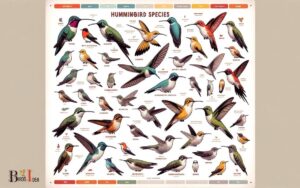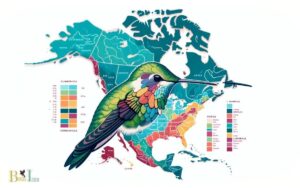Calliope Vs Broad Tailed Hummingbird: Comparison!
The Calliope Hummingbird (Selasphorus calliope) and the Broad-tailed Hummingbird (Selasphorus platycercus) are two distinct species with notable differences in size, plumage, and habitat preferences.
Calliope Hummingbirds are the smallest birds in North America and are known for their striking magenta throat feathers in males.
In contrast, Broad-tailed Hummingbirds are slightly larger with males sporting iridescent rose-red throats and a distinctive trilling sound produced by their wings.
Both species are found in western North America, with the Calliope preferring higher elevations and the Broad-tailed adapting to a variety of environments including gardens and woodlands.
The Calliope and Broad-tailed hummingbirds are two species distinguishable by their physical characteristics and behaviors:
For example, one might observe a Calliope Hummingbird in the high mountain meadows of the Rockies, while a Broad-tailed Hummingbird

Key Takeaway
Calliope vs Broad-tailed Hummingbird: A Detailed Comparison
| Feature | Calliope Hummingbird (Selasphorus calliope) | Broad-tailed Hummingbird (Selasphorus platycercus) |
|---|---|---|
| Size | 3-3.5 inches (7.6-8.9 cm) | 3.1-3.5 inches (7.9-9 cm) |
| Wingspan | Approximately 4.3 inches (11 cm) | 5.25 inches (13.3 cm) |
| Weight | 0.071-0.106 ounces (2-3 grams) | 0.1-0.2 ounces (3-6 grams) |
| Lifespan | About 4 years | Up to 9 years |
| Habitat | Mountainous areas, meadows, and forests | Open woodlands, mountain meadows |
| Range | Western North America | Western and Central North America |
| Migration | Migrates to Mexico and southern US | Migrates to Mexico and Guatemala |
| Breeding Season | May to July | April to July |
| Nesting | On low branches or shrubs | On trees or shrubs, occasionally at high elevations |
| Diet | Nectar, insects, and spiders | Nectar and insects |
| Distinctive Characteristics | Male has magenta throat feathers that appear streaked | Male has a rose-red throat and round tail |
| Conservation Status | Least Concern (LC) | Least Concern (LC) |
| Call/Song | High-pitched ‘tzip’ sound | High-pitched, cricket-like trill |
Physical Characteristics
How do the physical characteristics of the Calliope and Broad Tailed Hummingbirds differ?
The Calliope hummingbird (Selasphorus calliope) is the smallest bird species in North America, measuring around 3 inches in length, while the Broad Tailed hummingbird (Selasphorus platycercus) is slightly larger at about 4 inches.
The Calliope hummingbird exhibits a vibrant magenta-red gorget, whereas the Broad Tailed hummingbird displays a striking metallic rose-red throat patch.
Additionally, the Calliope hummingbird has a shorter and more straight-edged outermost tail feather, while the Broad Tailed hummingbird’s tail feathers are broader and notched.
Both species possess iridescent green plumage, but the Calliope hummingbird’s underparts are more buff-colored, whereas the Broad Tailed hummingbird’s underparts are white.
These distinct physical characteristics enable easy differentiation between these two hummingbird species.
Habitat and Range
The Calliope hummingbird and the Broad Tailed hummingbird inhabit distinct habitats due to variations in climate and elevation.
Calliope hummingbirds are typically found in mountainous regions of western North America, ranging from southeastern Alaska to California.
They prefer coniferous and mixed forests, often nesting in higher elevations where they can find suitable food sources and nesting sites.
In contrast, Broad Tailed hummingbirds are commonly found in more varied habitats, including mountain meadows, shrubby areas, and open woodlands throughout western North America.
They are known for their ability to thrive at higher elevations, sometimes venturing above the timberline in alpine tundra.
Understanding the differences in their habitats and ranges provides insight into the adaptations and behaviors of these two hummingbird species.
This variation in habitat and range also influences the feeding behavior of these hummingbirds.
Feeding Behavior
In relation to their distinct habitats and ranges, the feeding behavior of the Calliope and Broad Tailed hummingbirds reveals notable differences in their foraging patterns and dietary preferences.
Foraging Patterns:
- Calliope hummingbirds tend to forage at lower heights, often preferring flowers and shrubs closer to the ground.
- Broad Tailed hummingbirds exhibit more versatile foraging behaviors, visiting a wider range of floral species and frequently navigating higher altitudes.
Dietary Preferences:
- Calliope hummingbirds primarily feed on nectar from tubular flowers, favoring species such as penstemon and columbine.
- Broad Tailed hummingbirds have a more varied diet, incorporating insects and tree sap in addition to nectar, allowing them to exploit a wider array of food sources.
These differences in foraging patterns and dietary preferences reflect the specialized adaptations of each species to their respective ecological niches.
Mating and Nesting
Mating and nesting behaviors in Calliope and Broad Tailed hummingbirds are influenced by their distinct feeding habits and ecological niches.
The Calliope hummingbird, with its preference for higher elevations and mountainous regions, tends to mate and nest in coniferous or mixed woodlands.
The female constructs the nest, typically located on a horizontal branch or in a shrub, using plant down, lichen, and spider silk, camouflaging it with moss and lichen.
In contrast, the Broad Tailed hummingbird, found in more diverse habitats including mountain meadows and quaking aspen groves, builds its nest in a similar, but more open, fashion often near water sources.
Mating displays in both species involve aerial acrobatics and elaborate vocalizations, with males courting females through intricate flight patterns. These differing nesting strategies and mating displays reflect the species’ unique ecological adaptations.
Vocalizations
During courtship and territorial defense, Calliope and Broad Tailed hummingbirds produce distinctive vocalizations to communicate and assert their presence.
- Chirping: Both species emit high-pitched chirps during courtship displays, with Calliope hummingbirds producing a rapid, high-pitched trill, while Broad Tailed hummingbirds’ chirps are slightly lower in pitch and more rhythmic.
- Singing: Male Calliope hummingbirds perform elaborate song flights, producing a complex series of musical notes that vary in pitch and tempo. In contrast, male Broad Tailed hummingbirds sing simple, repetitive songs during their courtship displays.
- Chattering: Both species use chattering calls to defend their territories from intruders. Calliope hummingbirds produce a rapid, staccato-like chattering, while Broad Tailed hummingbirds emit a louder, more intense chattering sound.
- Aggression Calls: When engaging in aggressive interactions, both species produce sharp, piercing calls to intimidate rivals and assert dominance.
These vocalizations play a crucial role in communication and territorial defense for both Calliope and Broad Tailed hummingbirds. Understanding their vocal behaviors provides valuable insights into their ecology and behavior.
Migration Patterns
Migration patterns of the Calliope and Broad-tailed hummingbirds exhibit seasonal route variations, with each species displaying distinct preferences for altitude during migration.
Understanding the environmental impact on the migration of these hummingbirds is crucial for assessing their population dynamics and conservation status.
By examining these migration patterns, we can gain valuable insights into the behavior and ecology of these fascinating avian species.
Seasonal Route Variations
When studying the seasonal route variations of Calliope and Broad Tailed hummingbirds, it becomes evident that their migration patterns exhibit distinct differences in response to environmental factors.
- Timing: Calliope hummingbirds typically migrate earlier in the spring and later in the fall compared to Broad Tailed hummingbirds.
- Routes: Calliope hummingbirds tend to take a more direct route during migration, while Broad Tailed hummingbirds may follow a more circuitous path, influenced by the availability of nectar-producing plants.
- Altitude: Broad Tailed hummingbirds are known to migrate to higher elevations during the breeding season, while Calliope hummingbirds tend to remain at lower elevations throughout their migration.
- Breeding Grounds: Calliope hummingbirds often breed in mountainous regions, while Broad Tailed hummingbirds may breed in a wider variety of habitats, including montane and subalpine areas.
Understanding these variations in their migration patterns is crucial for conservation efforts and understanding the ecological needs of these species.
Altitude Preferences During Migration
Altitude preferences during migration reveal distinct differences between the Calliope and Broad Tailed hummingbirds’ seasonal route variations, with the latter species known to migrate to higher elevations during the breeding season.
The Calliope hummingbird, in contrast, tends to migrate to lower elevations, favoring mountain meadows, brushy areas, and streamside groves. These altitudinal preferences are crucial for both species’ survival and reproductive success.
The Broad Tailed hummingbird’s choice to migrate to higher elevations during the breeding season is linked to the availability of nectar-rich flowers in such habitats, aiding in meeting the energetic demands of breeding.
Conversely, the Calliope hummingbird’s preference for lower elevations is associated with the abundance of suitable nesting sites and food resources.
Understanding these altitude preferences during migration is pivotal for effective conservation and management efforts for these species.
Environmental Impact on Migration
The environmental conditions significantly influence the migratory patterns of Calliope and Broad Tailed hummingbirds.
This influence is evident in several ways:
- Food Availability: The availability of nectar-producing flowers along the migration route greatly impacts the hummingbirds’ movements. They follow the blooming patterns of specific flower species, shaping their migration routes accordingly.
- Climate Changes: Shifts in climate patterns, such as temperature and precipitation, can alter the timing of flower blooming, affecting the hummingbirds’ migration schedules.
- Habitat Loss: Human activities leading to habitat destruction can force hummingbirds to alter their traditional migration routes, impacting their energy expenditure and survival rates.
- Geographical Barriers: Natural obstacles like mountain ranges and large bodies of water can significantly influence the path of migration, leading to specific flight patterns and stopover locations.
Conservation Status
As we consider the conservation status of the Calliope and Broad Tailed Hummingbirds, it is crucial to address the threats to their habitat.
Additionally, the concerns regarding population decline must be thoroughly examined to understand the urgency of conservation efforts needed to protect these species.
By identifying the key factors contributing to their vulnerability, effective strategies can be implemented to ensure the survival of these hummingbird species.
Threats to Habitat
Both the Calliope and Broad Tailed hummingbirds face habitat loss and degradation, posing significant threats to their conservation status.
The following factors contribute to the decline and degradation of their habitats:
- Deforestation and urbanization: Both species are negatively impacted by the loss of their natural habitat due to deforestation for agriculture and urban development.
- Climate change: Shifts in temperature and precipitation patterns can lead to changes in the availability of suitable habitat and food sources for these hummingbirds.
- Pollution: Environmental pollution from pesticides, herbicides, and other chemicals can directly harm the hummingbirds and their food sources.
- Invasive species: Competition and predation from invasive species can disrupt the delicate ecological balance required for the hummingbirds’ survival.
These threats underscore the urgent need for conservation efforts to protect the habitats of these hummingbird species.
These threats underscore the urgent need for conservation efforts to protect the habitats of these hummingbird species.
Population Decline Concerns
Facing population decline concerns, conservation efforts for the Calliope and Broad Tailed hummingbirds are imperative to ensure their survival in the face of habitat loss and degradation.
Both species face threats such as habitat destruction due to urbanization, agriculture, and climate change. The Calliope hummingbird, in particular, has experienced a decline in its population due to the loss of high-altitude meadows and forests.
Similarly, the Broad Tailed hummingbird is confronting challenges related to the loss of mountainous habitats and the impact of climate change on flower availability.
These threats have led to concerns about the conservation status of both species. It is crucial to implement effective conservation strategies to mitigate these threats and safeguard the habitats necessary for the survival of these hummingbirds.
Conservation efforts needed for the Calliope and Broad Tailed hummingbirds will be discussed in the following section.
Conservation Efforts Needed
Conservation efforts for the Calliope and Broad Tailed hummingbirds are crucial to address the population decline concerns and ensure the preservation of their habitats in the face of ongoing threats.
- Habitat Protection: Preserving and restoring the natural habitats of these hummingbirds, including high-altitude meadows and mountainous areas, is essential for their survival.
- Reduction of Pesticide Use: Implementing regulations to minimize the use of pesticides in their habitats can help prevent harm to the hummingbirds and their food sources.
- Climate Change Mitigation: Addressing climate change through measures such as reducing greenhouse gas emissions can help protect the hummingbirds from the adverse effects of changing weather patterns.
- Public Awareness and Education: Educating communities about the importance of these hummingbirds and their habitats can garner support for conservation efforts and promote responsible interaction with these species.
These conservation efforts are vital for safeguarding the future of these unique hummingbird species.
Interaction With Humans
One can observe that both the Calliope and Broad Tailed Hummingbirds exhibit distinct behaviors when interacting with humans.
Calliope Hummingbirds are known for their bold and inquisitive nature, often approaching humans and showing curiosity towards feeders or flowers. They are less easily intimidated and may even hover close to observers.
On the other hand, Broad Tailed Hummingbirds tend to be more cautious and may keep their distance from humans, showing wariness in their interactions. They are also more likely to be driven away by human presence, especially in areas with high human activity.
Understanding these behavioral differences is crucial for creating environments that are conducive to the presence and well-being of both species, ensuring that human interactions do not disrupt their natural behaviors.
Conclusion
The comparison between the calliope and broad-tailed hummingbirds reveals fascinating differences in physical characteristics, habitat, feeding behavior, mating and nesting habits, vocalizations, migration patterns, and conservation status.
These intricate aspects of their lives highlight the complexity and diversity of the natural world, emphasizing the importance of understanding and preserving the delicate balance of ecosystems.
Just as each bird has its unique role in the environment, so too do we carry the responsibility to protect and conserve our natural world.






